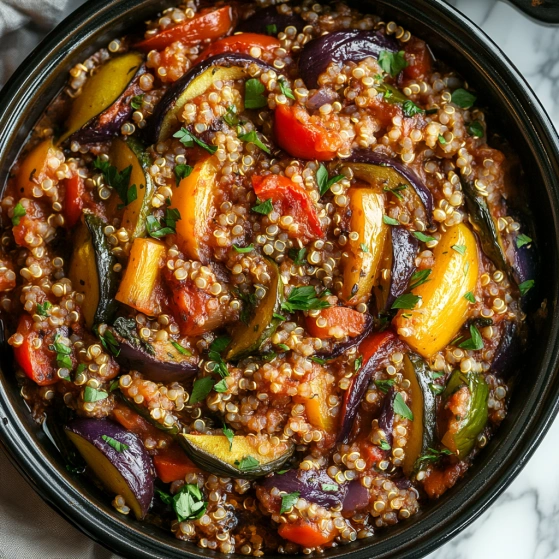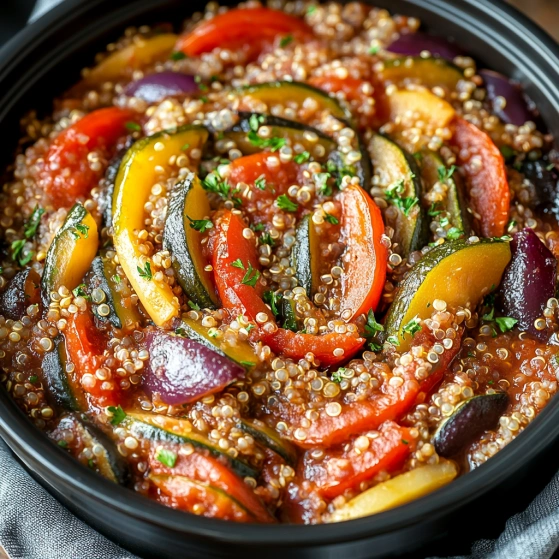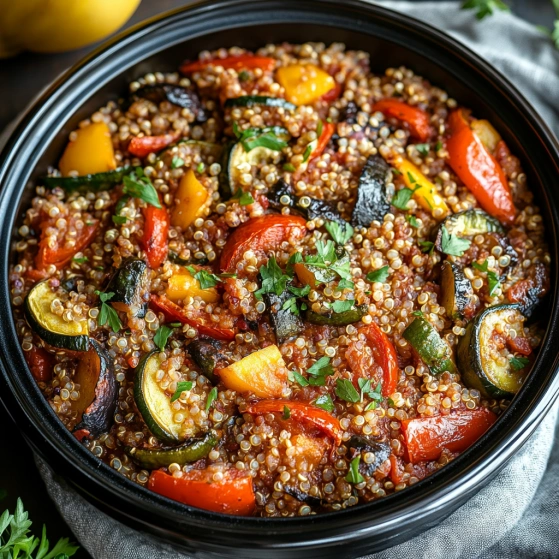 Pin it
Pin it
Ratatouille transforms into a complete meal when paired with protein-rich quinoa. This Mediterranean-inspired dish combines tender, slow-cooked vegetables with nutty quinoa for a satisfying vegetarian dinner that's both colorful and nutritious. The slow cooking process allows the flavors to meld beautifully, creating a rich, complex taste that feels like it took hours of careful attention rather than simple assembly.
I started making this quinoa ratatouille years ago when my garden produced too many zucchini and eggplants to handle. My family initially turned their noses up at the vegetables, but the slow-cooked flavors won them over completely. Now it's a summer staple we look forward to.
Ingredients and Why They Matter
- Eggplant: Absorbs flavors beautifully while adding meaty texture. Look for firm, glossy skin without soft spots.
- Zucchini: Provides sweetness and moisture. Choose medium-sized ones for best flavor.
- Bell Pepper: Adds natural sweetness and color. Red or yellow varieties work best for sweetness.
- Onion: Forms the flavor foundation. Yellow onions create the perfect savory base.
- Garlic: Essential for depth. Fresh cloves trump pre-minced every time.
- Diced Tomatoes: Creates the sauce. San Marzano variety offers superior flavor if available.
- Dried Herbs: Basil and thyme infuse Mediterranean character. Crush between fingers before adding to release oils.
- Quinoa: Delivers complete protein. Rinse thoroughly to remove natural bitter coating.
- Vegetable Broth: Enhances quinoa flavor. Homemade provides better taste, but quality store-bought works well.
Step-by-Step Cooking Instructions
- Step 1:
- Cut the eggplant into 1-inch cubes, making sure they're relatively uniform in size. Slice zucchini into half-moons about 1/2 inch thick. Chop bell pepper into 1-inch chunks after removing seeds and membranes. Dice the onion finely, and mince garlic cloves. The size of your vegetable cuts affects cooking time and texture, so aim for consistency.
- Step 2:
- Place onions and garlic at the bottom of the slow cooker, as they'll release moisture that prevents sticking. Add eggplant, zucchini, and bell pepper next. Pour the undrained diced tomatoes over everything, then sprinkle with herbs, salt, and pepper. Don't stir yet—layering helps control how the vegetables cook.
- Step 3:
- Cover the slow cooker with its lid and set to low for 6-8 hours if you're starting in the morning, or high for 3-4 hours if you're beginning later in the day. The low and slow method develops deeper flavors, but both approaches yield delicious results.
- Step 4:
- About 30 minutes before serving, rinse quinoa thoroughly under cold water using a fine-mesh strainer. This removes saponins that cause bitterness. Combine with vegetable broth in a medium saucepan. Bring to a boil, then reduce heat to low, cover, and simmer for 15-20 minutes until liquid is absorbed and quinoa displays its signature spiral.
- Step 5:
- Once vegetables are tender and quinoa is fluffy, gently stir the ratatouille mixture to incorporate all flavors. Taste and adjust seasonings as needed—I often find a splash of good olive oil and a squeeze of lemon brightens everything. Serve the ratatouille over a bed of quinoa, allowing the juices to soak into the grains.
 Pin it
Pin it
My husband once claimed he "didn't like eggplant" until I served this ratatouille. The slow cooking transforms it from potentially bitter and spongy to meltingly tender. Now he specifically requests dishes with eggplant, proving that proper cooking techniques can change even the strongest food opinions.
The Art of Vegetable Cutting
Uniform cutting isn't just for aesthetic appeal—it ensures even cooking throughout your ratatouille. I learned this lesson the hard way after serving a batch with some vegetables perfectly tender and others either mushy or undercooked. Take the extra few minutes to cut everything to similar sizes. For eggplant specifically, aim for slightly larger pieces as they shrink considerably during cooking. This attention to detail makes the difference between good ratatouille and great ratatouille, creating a dish where every bite delivers the perfect balance of vegetables.
Seasonal Adaptations Worth Trying
Ratatouille welcomes seasonal adjustments that keep the dish interesting year-round. In summer, when vegetables are at peak freshness, consider using yellow squash alongside zucchini for color variation. During cooler months, add hearty root vegetables like turnips or parsnips for a winter ratatouille. I've even incorporated butternut squash in autumn versions, which adds a subtle sweetness that pairs wonderfully with the tomato base. These adaptations maintain the essence of ratatouille while reflecting what's available and at its best.
 Pin it
Pin it
Making Ahead and Storage Wisdom
This dish actually improves with time as flavors continue developing, making it ideal for meal planning. Prepare the entire recipe and refrigerate for up to four days, or freeze portions for up to three months. When reheating, add a splash of broth or water as the quinoa tends to absorb moisture during storage. For workday lunches, I store the ratatouille and quinoa separately, reheating the vegetables thoroughly before adding to room-temperature quinoa—this prevents the quinoa from becoming overcooked and mushy. The convenience of having this nutrient-dense meal ready to go has saved my dinner plans countless times.
Frequently Asked Questions
- → What makes this a healthy option?
This dish combines fiber-rich vegetables with protein-packed quinoa, making it nutrient-dense and satisfying.
- → Can I use a different grain instead of quinoa?
Yes, you can substitute quinoa with grains like couscous, bulgur, or brown rice for a similar texture and flavor.
- → How can I adjust seasoning levels?
You can add more basil or thyme based on your preference or include a pinch of chili flakes for added heat.
- → Can this dish be made ahead of time?
Absolutely! Prepare it ahead and store it in the fridge for up to 3 days. Reheat on the stovetop or microwave before serving.
- → Is there a way to make it gluten-free?
This dish is naturally gluten-free as it uses quinoa and vegetables. Ensure your vegetable broth is gluten-free as well.
